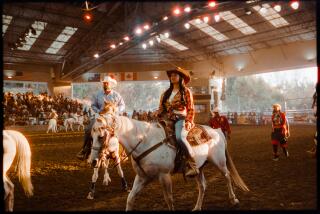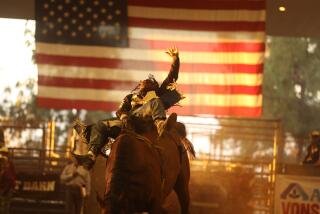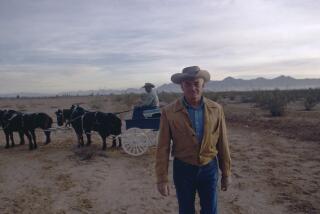‘Ride ‘em Cowboy’ Rodeos Lasso New Fans in Brazil
BARRETOS, Brazil — The cowboys line up silently in the arena, the image of Texas from the brim of their Stetsons to the tips of their fancy-stitched boots.
But then they kneel in the dirt, remove their hats and pray as a 3-foot statue of a black-skinned Virgin Mary--”Our Appeared Lady,” Brazil’s patron saint--is paraded before them to receive their reverent touch.
And when a humpbacked Zebu bull rockets out of the chute, the announcer hollers: “Seguuuuuuuuura, peao!”--Portuguese for “Ride ‘em, cowboy.”
This is Barretos, the rodeo capital of Brazil and the hub of what has grown into a $500-million-a-year industry.
About 1,200 rodeos were held in Brazil in 1996, says Jeronimo Luiz Muzzetti, president of the National Rodeo Federation. They drew about 30 million people, 25% more than the previous year, and generated 200,000 direct and indirect jobs.
“You can watch a soccer game for 90 minutes and not see a goal. With rodeo, every eight seconds is a goal,” Muzzetti says when asked to explain rodeo’s fast-growing popularity in the land of Pele.
With its 10-acre Cowboy Park and horseshoe-shaped stadium that holds 35,000 people, the Barretos rodeo is the country’s biggest. More than 1 million people attended the latest 10-day event.
More than a rodeo, Barretos is a celebration of “cauboi” culture. There’s a Miss Rodeo beauty pageant, nightly shows of Brazilian country music, known as “sertaneja,” and exhibitions of traditional singing and square dancing.
The main event, of course, is the riding competition.
About 250 cowboys from the rural interior of central and southern Brazil competed for $250,000 in prizes. As a special attraction, 13 American and Canadian cowboys were flown down for the event.
To the delight of the partisan crowd, two local cowboys rode away with the top prizes. Osmar Alves de Oliveira took first in the saddle bronc and Rinaldo da Silva won the bull riding. Both took home $20,000 in prize money.
Helio Bruno Barbosa recalls how different it was four decades ago when the first rodeo was held in the town square. It was started by Barbosa and 18 other well-to-do young men who formed a charity group called the Independents.
“We always had a lot of cowboys in town, so we figured we’d start a rodeo to raise some money for charity,” he says. “But I never imagined it would get this big.”
Today, the Independents want to make Barretos a permanent part of the international rodeo circuit.
To that end, Barretos features a full slate of events in line with the standards of the American Professional Rodeo Cowboys Assn. They include team roping, calf roping, steer wrestling, barrel racing and saddle bronc, bareback and bull riding.
The only concession to local tradition is an event called “cutiano,” a Brazilian style of bareback riding. The cowboy hangs on by two ropes and gets no help to dismount.
Brazilian cowpunchers also have their own distinctive gear, such as the “goiaca,” a pouch that doubles as a belt, and the “berrante,” a sort of trumpet made from a spiraling steer’s horn used to guide the herd on a cattle drive.
But while traditions persist, the rodeo that is capturing the imagination of Brazilians has a distinctly U.S. flavor.
Inside the arena, the rodeo clowns have American flags on their shirts. Outside, young men and women dressed in their Texas finest dance textbook-perfect two-steps on the corner.
Many in the young, affluent crowd are John-Wayne-come-latelies. Their tastes run to imported pickup trucks and $300 foreign-made boots. Few were country music fans when country wasn’t cool.
“The only ones here who are really cowboys are the cowboys. Everyone else is just dressing up,” says Ruth Araujo, a journalist for Hippus, a magazine dedicated to equestrian sports.
Santel Melima, who was reared in Porto Velho in far western Rondonia state, isn’t just dressing up. He has the scars and an artificial knee, from being trampled by a bull a few years ago, to prove it.
“I’ve been riding since I was this high,” Melima says, holding his hand just barely above a big silver belt buckle that looks as if it could stop a bullet.
One of the about 1,000 Brazilians who make a living as professional rodeo riders, Melima says he earns between $40,000 and $60,000 a year. Like most cowboys here, he dreams of competing in the United States.
Preparing for his moment of glory, Melima swings his arm behind his back a couple of times to loosen up, then climbs the side of the wooden holding pen and eases onto the back of a quarter-ton white bull.
He carefully grips the rope cinch with one leather-gloved hand as the bull snorts and rubs against the chute.
And when the yellow gate swings opens and bull and rider explode into the arena, it suddenly doesn’t matter if it’s Barretos or Houston or Calgary. For the next eight seconds--if the ride lasts that long--the only place that counts is on top of that bull.
More to Read
Sign up for Essential California
The most important California stories and recommendations in your inbox every morning.
You may occasionally receive promotional content from the Los Angeles Times.










